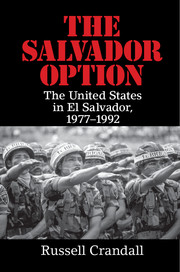1 - Introduction
Published online by Cambridge University Press: 05 June 2016
Summary
Winning the Cold War is not a pretty thing when you look into it.
– Jefferson Morley, novelist and Washington Post correspondent, 1992“Unimaginable Sight of a Sea of Black-and-Red Guerrilla Flags”
The civil war between El Salvador's government and Marxist guerrillas began in 1980 and endured for 12 cruel years. Even for Central America's violent ways during the Cold War, the Salvadoran conflict was exceptionally bloody; it took roughly 75,000 lives and displaced more than a million people in this tiny, impoverished Central American nation of 5 million. Unwilling to tolerate an advance of apparent Soviet and Cuban-backed communism in its geopolitical backyard in what turned out to be the last phase of the Cold War, three successive U.S. presidential administrations (Jimmy Carter, Ronald Reagan, and George H. W. Bush) provided more than $6 billion in military and economic aid to the Salvadoran government. The goal was to check the most formidable guerrilla insurgency – collectively known as the Farabundo Martí National Liberation Front (El Frente Farabundo Martí para la Liberación Nacional, FMLN) – in Latin America's modern history. This effort was America's largest counterinsurgency and nation-building campaign after Vietnam and before Iraq and Afghanistan.
At a 19th-century castle in Mexico City on January 16, 1992, after a couple years of exhausting and sporadic UN-led negotiations, the Salvadoran government signed a peace deal with the Marxist rebels. To the surprise of many observers, the 1992 peace pact led to a complete ceasefire and demobilization over the next year that formally ended the civil war. Equally striking, the agreement reduced the Salvadoran military's size and budget and authorized the guerrillas’ transformation from a Marxist insurgency into a democratic political party. Because many of the key measures of the peace agreement involved drastic reforms to the Armed Forces of El Salvador (Fuerzas Armadas de El Salvador, FAES) and state intelligence services as well as the guerrillas’ acceptance of the democratic system they had fought against, the Salvadoran peace agreement was dubbed a “negotiated revolution.” This propitious outcome was even more dramatic in the aftermath of a ferocious guerrilla offensive in late 1989 that led many observers to conclude that the brutal war had no end in sight.
- Type
- Chapter
- Information
- The Salvador OptionThe United States in El Salvador, 1977–1992, pp. 1 - 12Publisher: Cambridge University PressPrint publication year: 2016

